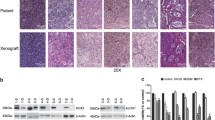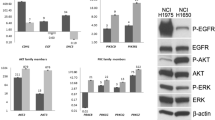Abstract
The standard of care for advanced non-small cell lung cancer (NSCLC) consists in cisplatin-combination chemotherapy. In patients bearing tumors with activating mutations of the epidermal growth factor receptor (EGFR), the inhibition of the EGFR intracellular tyrosine kinase can induce up to 80 % response rates. However, both therapeutic strategies will eventually lead to recurrent disease due to the development of drug resistance. The identification of rare cancer stem-like cells able to repopulate the tumor, after failure to standard treatment modalities, has led to characterize these cells as potential therapeutic targets. This article will address the role of the CD133/EpCAM stem cell-related markers and explore cell sensitivity to cisplatin and to the EGFR-tyrosine kinase inhibitor, afatinib. Three human NSCLC cell lines, one wild-type (A549) and two harboring EGFR mutations (H1650 and H1975), as well as 20 NSCLC primary cultures, were grown in non-differentiating culture conditions for stem cell enrichment. Flow-cytometry analyses of CD133 and EpCAM and cell sensitivity to cisplatin and afatinib were performed. Moreover, the expression of activated EGFR was assessed by Western blot. The cell lines and primary cultures grown in non-differentiating culture conditions were enriched with CD133/EpCAM-positive cells and were significantly more resistant to cisplatin and more sensitive to afatinib as compared to the differentiated counterpart. In addition, increased EGFR-phosphorylation in non-differentiated cultures was observed. The present findings suggest that afatinib might be beneficial for patients bearing tumors with constitutively activated EGFR, to target chemo-resistant CD133/EpCAM-positive cancer stem cells.





Similar content being viewed by others
References
Abhold EL, Kiang A, Rahimy E et al (2012) EGFR kinase promotes acquisition of stem cell-like properties: a potential therapeutic target in head and neck squamous cell carcinoma stem cells. PLoS One 2:e32459
Alama A, Orengo AM, Ferrini S et al (2012) Targeting cancer-initiating cell drug-resistance: a roadmap to a new-generation of cancer therapies? Drug Discov Today 17:435–442
Bertolini G, Roz L, Perego P et al (2009) Highly tumorigenic lung cancer CD133 cells display stem-like features and are spared by cisplatin treatment. Proc Natl Acad Sci USA 106:16281–16286
Chang A (2011) Chemotherapy, chemoresistance and the changing treatment landscape for NSCLC. Lung Cancer 71:3–10
Chen S, Huo X, Lin Y et al (2010) Association of MDR1 and ERCC1 polymorphisms with response and toxicity to cisplatin-based chemotherapy in non-small-cell lung cancer patients. Int J Hyg Environ Health 213:140–145
Chen Y, Yu D, Zhang H et al (2012) CD133(+)EpCAM(+) phenotype possesses more characteristics of tumor initiating cells in hepatocellular carcinoma Huh7 cells. Int J Biol Sci 8:992–1004
Cufer T, Ovcaricek T, O’Brien ME (2013) Systemic therapy of advanced non-small cell lung cancer: major-developments of the last 5-years. Eur J Cancer 49:1216–1225
Favoni RE, Alama A (2013) Preclinical strategies targeted at non-small-cell lung cancer signalling pathways with striking translational fallout. Drug Discov Today 18:11–24
Ferlay J, Shin HR, Bray F et al (2010) Estimates of worldwide burden of cancer in 2008: GLOBOCAN 2008. Int J Cancer 127:2893–2917
Galvani E, Giovannetti E, Saccani F et al (2013) Molecular mechanisms underlying the antitumor activity of 3-aminopropanamide irreversible inhibitors of the epidermal growth factor receptor in non–small cell lung cancer. Neoplasia 15:61–72
Gottschling S, Herpel E, Eberhardt WE et al (2012) The gefitinib long-term responder (LTR)—a cancer stem-like cell story? Insights from molecular analyses of German long-term responders treated in the IRESSA expanded access program (EAP). Lung Cancer 77:183–191
Levina V, Marrangoni AM, DeMarco R et al (2008) Drug-selected human lung cancer stem cells: cytokine net-work, tumorigenic and metastatic properties. PLoS One 3:e3077
Li D, Ambrogio L, Shimamura T et al (2008) BIBW2992, an irreversible EGFR/HER2 inhibitor highly effective in preclinical lung cancer models. Oncogene 27:4702–4711
Maugeri-Saccà M, Vigneri P, De Maria R (2011) Cancer stem cells and chemosensitivity. Clin Cancer Res 17:4942–4947
Mazzoleni S, Politi LS, Pala M et al (2010) Epidermal growth factor receptor expression identifies functionally and molecularly distinct tumor-initiating cells in human glioblastoma multiforme and is required for gliomagenesis. Cancer Res 70:7500–7513
Munz M, Baeuerle PA, Gires O (2009) The emerging role of EpCAM in cancer and stem cell signaling. Cancer Res 69:5627–5629
Neuzil J, Stantic M, Zobalova R et al (2007) Tumor-initiating cells vs. cancer ‘stem’ cells and CD133: what’s in the name? Biochem Biophys Res Commun 355:855–859
Nguyen KS, Kobayashi S, Costa DB (2009) Acquired resistance to epidermal growth factor receptor tyrosine kinase inhibitors in non-small-cell lung cancers dependent on the epidermal growth factor receptor pathway. Clin Lung Cancer 10:281–289
Nguyen LV, Vanner R, Dirks P et al (2012) Cancer stem cells: an evolving concept. Nat Rev Cancer 12:133–143
Ono M, Kuwano M (2006) Molecular mechanisms of epidermal growth factor receptor (EGFR) activation and response to gefitinib and other EGFR-targeting drugs. Clin Cancer Res 12:7242–7251
Pao W, Miller V, Zakowski M et al (2004) EGF receptor gene mutations are common in lung cancers from “never smokers” and are associated with sensitivity of tumors to gefitinib and erlotinib. Proc Natl Acad Sci USA 101:13306–13311
Peacock CD, Watkins N (2008) Cancer stem cells and the ontogeny of lung cancer. J Clin Oncol 26:2883–2889
Singh S, Trevino J, Bora-Singhal N et al (2012) EGFR/Src/Akt signaling modulates Sox2 expression and self-renewal of stem-like side-population cells in non-small cell lung cancer. Mol Cancer 11:73
Skirecki T, Hoser G, Kawiak J et al (2014) Flow cytometric analysis of CD133- and EpCAM-positive cells in the peripheral blood of patients with lung cancer. Arch Immunol Ther Exp 62:67–75
Tan DS, Gerlinger M, Teh BT et al (2010) Anti-cancer drug resistance: understanding the mechanisms through the use of integrative genomics and functional RNA interference. Eur J Cancer 46:2166–2177
Zandi R, Larsen AB, Andersen P et al (2007) Mechanisms for oncogenic activation of the epidermal growth factor receptor. Cell Signal 19:2013–2023
Acknowledgments
This work was supported by grant from Compagnia San Paolo and AIRC. We thank Dr. Alice Gino for technical help.
Conflict of interest
The authors declare no conflicts of interest regarding this study.
Author information
Authors and Affiliations
Corresponding author
Additional information
A. Alama and R. Gangemi equally contributed to this work.
Electronic supplementary material
Below is the link to the electronic supplementary material.
About this article
Cite this article
Alama, A., Gangemi, R., Ferrini, S. et al. CD133-Positive Cells from Non-Small Cell Lung Cancer Show Distinct Sensitivity to Cisplatin and Afatinib. Arch. Immunol. Ther. Exp. 63, 207–214 (2015). https://doi.org/10.1007/s00005-015-0330-5
Received:
Accepted:
Published:
Issue Date:
DOI: https://doi.org/10.1007/s00005-015-0330-5




